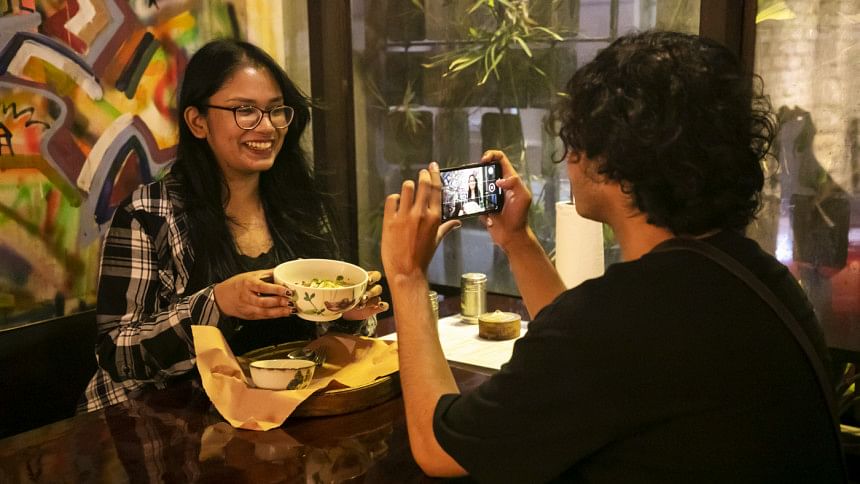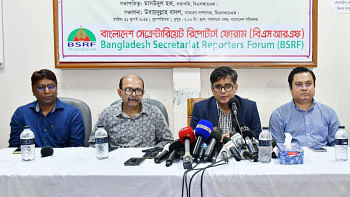Inside the world of food vlogging

Whether you live vicariously through food vloggers eating at places you could never afford or just enjoy seeing videos of aesthetic restaurants, there's a 99 percent chance you've encountered a restaurant review on social media. What started as a small community of people posting for fun has gained overwhelming mainstream prominence. In a country with a lack of activities to do, food content is a big reason young people stay active on platforms.
Food content creation in 2023 has come a long way from when a man with a smartphone and a dream decided to take on Takeout 2.0. So, how is the content that magically pops up on our feeds made?
Let's start from the beginning: why do people make content?
There isn't a one-size-fits-all answer to this, and everybody has their reasons for starting. Noodar Yasmeen, @noodareats, an up-and-coming food content creator mainly active on Instagram, says, "Food is something me and my cousin always bonded over. So, I decided to take a chance on my platform to share my love and knowledge on food-related content and help others connect over it."
On the other hand, Shahbaz Amin Bhuiyan, one-half of the vlogging duo Recommended Or Not, which is active both on Instagram and Facebook, decided to start posting after seeing a need for proper reviews.
"I used to go out to eat a lot seeing reviews on social media, but the food and atmosphere didn't always meet my expectations. I realised there was a shortage of sincere food reviews, which motivated me to open a page where I could post my reviews and help people," he says.
There's a lot of planning that goes into creating a video. As hard as it might be to believe, you can't just film yourself wolfing down food and post it impromptu. First comes the ideation stage, preferably, you want to create content that captures your audience's attention, which requires insight into what's popular.
"Before we film, me and my friends spend a lot of time researching and coming up with video ideas that could generate hype and traction," says Iftekhar Rafsan, more commonly known as Rafsan the Chotobhai.
While most restaurants don't mind creators, it's best to let them know ahead of time to allow them to accommodate you without disturbing any patrons. However, brace yourself for some degree of awkwardness.
"People's reactions to me filming used to bother me a lot initially, but I've gotten used to the stares and try not to pay attention to them," details Nazia Zaman, also known as Whatsinmybox on YouTube and Instagram.
Speaking of equipment, the myth that you need a whole reality television-style crew and camera production for shooting videos simply does not hold true.
Elaborating on this, Rafsan the Chotobhai states, "I started filming with my OnePlus 3T and used my friend's phone for recording audio and lighting. I upgraded to an iPhone X after going past 300K subs. Last year, I shot a video having coffee on top of the Burj Khalifa on my phone that got over seventeen million views, performing way better than many of my better-produced videos."
But if a content creator starting out wants to buy equipment, a digital camera, a shotgun microphone, a tripod, and a ring light is good enough to start. As your page grows, managing it only gets more challenging.
"I have a team of around nine people to run the brand, but when I started out, I had to be very hands-on and manage the planning, editing, and other nitty-gritty aspects of my page all on my own," says Rafsan.
After sorting out the logistics and equipment, you'll have to go out and judge the food and restaurant. So how do creators judge a place to review?
When asked, Noodar says, "Obviously, the food. I always compare the quality to the price point, as I don't expect to get similar quality food from a 100 taka meal compared to a 500 taka one. The restaurant's location and ambience also matter, and finally, the service is really crucial, as it can make or break the entire experience."
When editing, you need to make stylistic choices based on the platform you'll post on. For Facebook, videos are longer and more vlog style because it has to be kept in mind that they will reach the general public. However, some creators, like Noodar, make shorter videos on TikTok and Instagram, which suit the algorithm and her audience's preferences.
After all of that's accounted for, you'll finally have content woth sharing. Managing a social media presence demands skill and grit. Videos must be optimised based on the platform it's intended to serve.
"Replying to comments and messages and posting regular reviews while keeping track of the timing is crucial for running a successful page," says Shahbaz.
Facebook remains the go-to platform for food-related content in Bangladesh. While newer platforms dominate certain demographics, Facebook's large reach makes it prime real estate for reviewing food and creating content. Despite its pitfalls, Facebook can be a springboard for reviewing food and content creation.
Moving forward, there's obviously a lot of work put into running a social media presence, and holding down such a large commitment being a full-time student or job holder can be taxing.
"A lot of effort goes into creating content, and it becomes hard to balance the two. During certain times, I've lost motivation to create content as I wasn't in the right headspace to be creative," remarks Nazia.
On the other hand, female content creators are susceptible to a unique form of struggle – misogyny. Unfortunately, many viewers don't feel comfortable with the idea of women creating food review videos.
Fahrin Zannat Faiza, the digital creator behind the popular food vlogging channel Khudalagse, shares her experience from her early days. She says, "During the initial days of my channel, there weren't many females in this industry, and a lot of people found it hard to accept a woman being in front of the camera, eating out in restaurants and making videos about them. Things have changed a lot since then, and thankfully, the overwhelming support of my family and community kept me going."
She adds, "Even the restaurants are more open to food content creators these days. There is an increasing number of people in the content creation world who bring in a lot of quality content and it makes restaurant staff receive us with more enthusiasm."
Barring exceptions, making content can be a good side hustle but not a viable alternative to stable employment. There are going to be sponsorship opportunities occasionally, but getting a channel monetised is a lot of work, and YouTube doesn't pay enough to live off on.
"As creators in Bangladesh, it's harder for us to be included in Instagram's Reels Play bonus program or the TikTok Creator Fund. So, having it as a career isn't viable without a backup income," says Noodar.
There's also a lot of hesitation regarding getting started, to which Shahbaz suggests just doing it. "You might be bad at taking pictures or writing reviews at first, but you'll never be good at it if you don't start. And once you start, you'll only get better at it," he says.
Faiza remarks, "The only advice I always give is to start creating if you have the passion for it. Getting into content creation simply because everyone else is doing it would be a waste of time, money and effort."
On the other hand, Rafsan says, "If you're gonna start out now, focus on originality and differentiating yourself, and be prepared to grow a thick skin. You'll need it to deal with the comment section."
Writing this article made Taaseen want to eat tacos. Suggest taco places at [email protected]
Irina does not like tacos. Send her your controversial food opinions at [email protected]

 For all latest news, follow The Daily Star's Google News channel.
For all latest news, follow The Daily Star's Google News channel. 



Comments